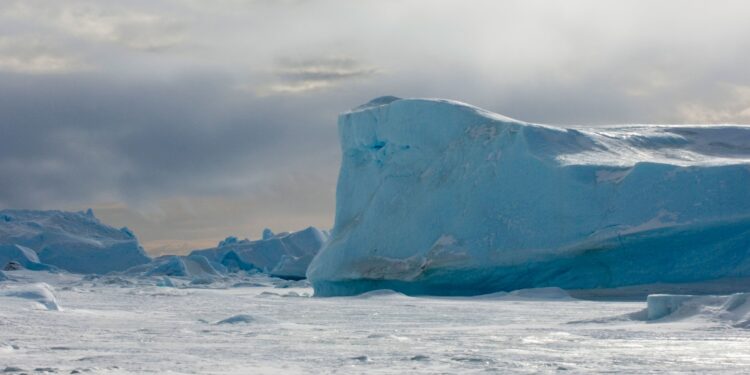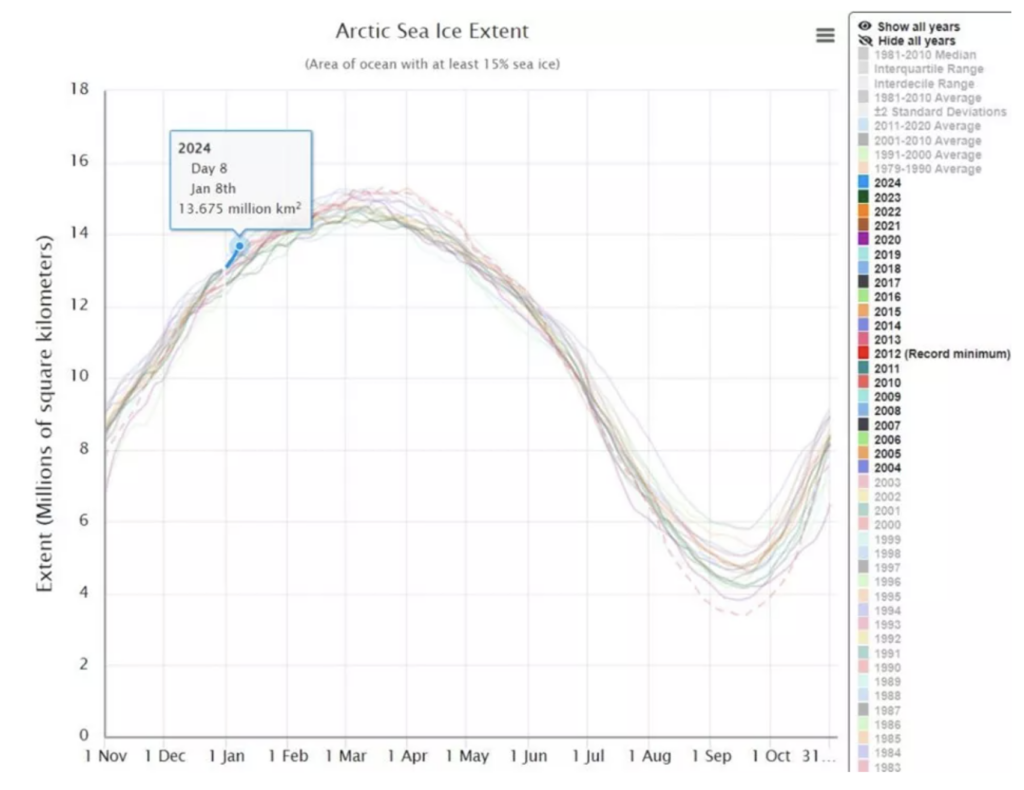Arctic Sea Ice Soars To Its Highest Level In 21 Years
by Chris Morrison of the Daily Sceptic

The dramatic, yet largely ignored, recovery in Arctic sea ice is continuing into the New Year.
Despite the contestable claims of the ‘hottest year ever’ (and even hotter in 2024), Arctic sea ice on January 8th stood at its highest level in 21 years. Last December, the U.S.-based National Snow and Ice Data Centre (NSIDC) revealed that sea ice recorded its third-highest monthly gain in the modern 45-year record. According to the science blog No Tricks Zone, the reading up to January 8th has now far exceeded the average for the years 2011-2020. It also exceeds the average for the years 2001-2010 and points directly upwards waboutthe average for the years 1991-2000.
The graph below shows the scale of the recovery compared to all the years tracked in the modern satellite record.

Of course, this is only about half a winter’s worth of data, and we must be careful not to follow alarmists down their chosen political path of cherr- picking and warning of climate collapsebased onf individual events. But as we have seen in recent Daily Sceptic articles, the current recovery in Arctic sea ice is a climate trend that can be taken back to around 2007. In a recent paper, the Danish scientist Allan Astrup Jensen provided data showing a fall in the sea ice between 1997 and 2007 but minimal losses in the 45-year record both before and after this period. The investigative journalist Tony Heller draws a four-year moving average to show a small recovery in the lowest ice extent in September from around 2012. He also notes that 1979 was a recent high point, with lower ice levels in the 1970s going back to the 1950s.
Where does all this leave the alarmists promoting their insane collectivist Net Zero project? Stuck up a frozen creek without an ice pick, it might be suggested. In 2022, Sir David Attenborough told BBC viewers that the summer sea ice could all be gone within 12 years. Climate models fed with opinions and wishful thinking seem to have guided him in his lamentations rather than the actual data. But if the ice continues to roar back, the sea ice scare will likely have to be retired, along with all the disappearing coral popping up in record amounts on the Great Barrier Reef.
Cyclical natural climate variations, observed in the record going back to the early 1800s, appear to offer a better explanation of trends in the polar sea ice extent. Little unde-stood effects of ocean currents and atmospheric heat exchanges are obvious drivers of the climate in the far north. Taking the view that humans, and only humans, control the climate temperature would appear to be a dead end in understanding Arctic glaciology.
Ditto Antarctica, where the cherry-pickings for catastrophists seemed to offer good prospects of late. Last year the BBC reported on lower levels of winter sea ice than those recorded in the recent past. The BBC said it showed a new benchmark for a region “that once seemed resistant to global warming”. This inconvenient resistance of course refers to the fact that Antarctica has shown “nearly non-existent” warming over the last 70 years. Dr. Walter Meier from the NSIDC helpfully added: “It’s so far outside anything we’ve seen, it’s almost mind-blowing.” The “mind-blowing” quote made headlines around mainstream media. Alas, Dr. Meier seemed to forget that barely a decade ago he was part of a science team that cracked the secrets of early Nimbus satellite data that showed even lower winter levels of sea ice in 1966
At the time, the Nimbus team won awards and the Daily Sceptic has been able to jog Dr. Meier’s memory of what he said at the time.
Even in the passive microwave record [available since 1979] for the Antarctic you see these seesaws where the ice concentrations go up and down, so extreme high or extreme low is not that unusual. What the Nimbus data tells us is that there’s variability in the Antarctica sea ice that’s larger than any we had seen from the passive microwave data. Nimbus helps put this in a longer -erm context and extends the record.
Three cheers for the longer record. It doesn’t seem to get much of a look-in these days as the Earth starts to boil. Below, Professor Ole Humlum maps the sea ice extent in Antarctica going back to 1979.

Allan Jensen looks at the same data and notes that any downward trend in the period was very small. The only discernible trend is a rise from around July 2013 followed by a small fall. Jensen points to a recent decline in 2022 and 2023. But, of late, any decline has been slowed with the NSIDC-recorded extent at the end of the last month only the sixth lowest in the record.
Chris Morrison is the Daily Sceptic’s Environment Editor.